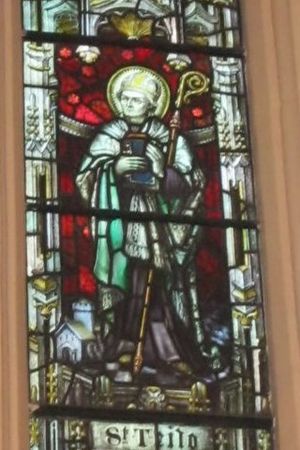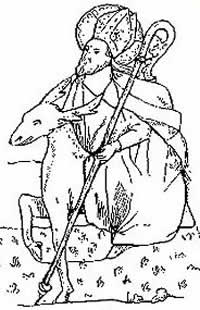Saint Teilo facts for kids
Quick facts for kids Saint Teilo |
|
|---|---|

St Teilo in Holy Trinity Church, Abergavenny
|
|
| Born | c. 500 Penally, Pembrokeshire, Wales |
| Died | c. 560 Llandeilo Fawr |
| Venerated in | Catholic Church Eastern Orthodox Church |
| Feast | 9 February (Wales) 25 November (Brittany) 29 November (Dol) |
| Patronage | Cardiff |
Saint Teilo (also known as Eliud in Cornish) was an important Christian monk and bishop from Wales. He lived around the years 500 to 560. Teilo helped start many churches and monasteries. He was born in a place called Penalun (now Penally) in south Wales, near Tenby.
People say he was a cousin and good friend of Saint David, another famous Welsh saint. Teilo became the bishop of Llandaff and helped build the first church at Llandaff Cathedral. His tomb is still there today. He also founded Llandeilo Fawr and Penally Abbey.
Contents
The Life of Saint Teilo
Teilo was born in Penalun around the year 500. His father was Ensich ap Hydwn. He was also thought to be the brother of Anowed. Some stories say he was the uncle of Saints Ismael and Euddogwy.
Teilo went to school at two important places. First, he studied with a famous church leader named Dubricius. Then, he went to a school run by Paulinus of Wales at a place believed to be Whitland. Here, he met Saint David (Dewi), and they became very close friends.
Teilo's Adventures and Leadership
Like many leaders of his time, Teilo had some exciting experiences. With his friends Aeddan and Ysfael, he traveled to Mynyw (now St. Davids). There, Saint David started his abbey. Teilo and his friends helped remove an Irish pirate named Bwya. They even burned his fort down!
After Dubricius retired, Teilo became the Bishop of Llandaff. He started the first church in Llandaff. He also led a school for monks and became a bishop over the areas of Glywysing and Gwent.
Journey to Brittany
Around the 540s, a terrible sickness called the "yellow plague" (similar to the Plague of Justinian) spread across Britain. In 549, Teilo and a small group of monks moved to Dol in Brittany, which is in France.
He stayed in Brittany for about seven years and seven months. This means he likely returned to Wales around 556 or 557. On his journey, he traveled through Dumnonia. He met King Geraint and joined Samson of Dol in Dol. Even today, fruit groves they planted are known as the groves of Teilo and Samson. There's a legend that Teilo even tamed a fierce winged dragon in Brittany!
Teilo's Passing and Legacy
After his time in Brittany, Teilo returned to Llandeilo Fawr. He passed away on February 9th, probably around the year 560. After his death, Teilo became one of the most respected people in Wales.
A story says that when Teilo died, his body miraculously became three identical bodies. This might be because three different churches wanted to have his holy remains. These churches were Llandaff Cathedral, Llandeilo Fawr, and Penally Abbey.
One of his tombs is in Llandaff Cathedral. His skull is kept in a special container called a reliquary in the south chapel. Many miracles were said to happen at his tomb. Today, parts of his relics are also honored in other places like Landeleau, Plogonnec, and Saint-Thélo.
Saint Teilo in the Roman Martyrology
The Roman Martyrology is a book that lists saints and their feast days. In its 2004 edition, Saint Teilo is listed under February 9th. His Latin name is Teliávus.
He is recognized as a bishop and abbot (leader of a monastery) at Llandaff in Wales. He is known for his hard work for the church in Wales and Cornwall. He is also celebrated in Brittany (Armorica). In many churches in Brittany, you might see pictures of him riding a stag (a male deer).
Lasting Impact and Dedications
Saint Teilo's influence is still seen today. At least 25 churches and schools are named after him. These are found in Wales, Brittany, Cornwall, and Devon. Examples include St Teilo's Church in Llandeloy and St Teilo's Church in Wales High School in Cardiff.
There are also three villages in Brittany named after him: Landeleau, Landêliau, and Saint-Thélo. Saint Teilo is the special patron saint of the city of Cardiff.
Festival Days
People celebrate Saint Teilo on different days in different places. In Wales and at Saint Télo, his festival is on February 9th. In Dol, it's on November 29th. In other churches in Brittany, it's on November 25th.
After the calendar changed in 1752, his fair at Llandeilo in Wales was celebrated on February 20th, or the Sunday after that date.
See also
- Merthyr Dyfan



